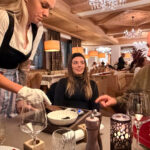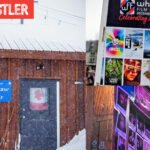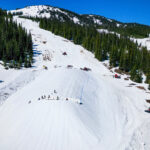It’s tougher than you think filling in the blanks on a resort trail map.
The single best run name anywhere, in my opinion, is at Lake Louise Ski Resort. You won’t find it on any trail map, but the Orchidometer is a towering rock with a cleft that funnels skiers toward a mandatory air. The landing is tight. In the medical world, an orchidometer is a tool used to measure the volume of a patient’s testicles. The name is perfect, and if it were widely known, the run would be legendary. Who wouldn’t want to see how he (or she) measures up?
Lucky for me, it was closed on my last visit as I showed Danny Corrigan, a childhood friend back for a visit from Australia, around The Lake. It did get us talking about run names, though.
This season, Lake Louise is adopting nearly 200 hectares of what used to be backcountry terrain known as West Bowl. A lot of runs are going to need names. Off the south face of Whitehorn Mountain, West Bowl is a huge area to get lost in, and whether you are skiing it, working in it or requesting a rescue, places need names.
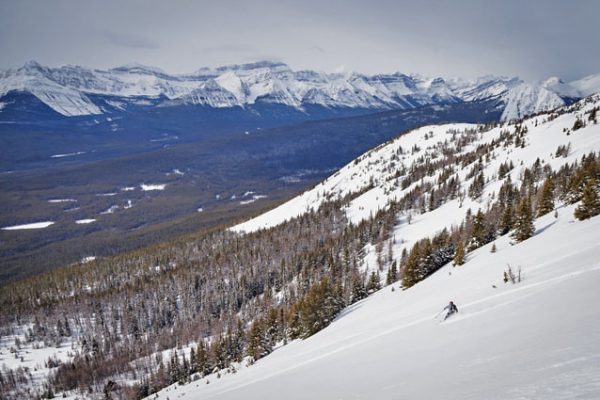
The main line down West Bowl starts with a wide-open panel of white that funnels into a drainage below and ends with a traverse back toward the base area, 1,000m below the peak. Farther out along the top ridge, the angles mellow and runs quickly transition into spacious larch forest and, finally, tighter pines. It’s the type of area where skiers are always poking over the next bump to see what hidden treasures lurk, and it’s vast enough to keep them searching for days.
As one of the busiest backcountry ski zones in Banff National Park, there are already many informal names for places in West Bowl. But are those the names a business would choose to advertise? Exciting names bring interest, but even in 2020 names on a map need to live up to a certain political correctness, even in Alberta. As everyone knows—well, maybe not everyone—the central funnel below the centre of West Bowl, for example, is called Deep Throat. It’s safe to say you won’t see that, or the less-obvious Cheap Throat beside it, on any trail maps or official run lists.
Dan Markham, formerly the director of Brand and Communication at Lake Louise, told me that official names need to pass a certain “family sniff test.” So how do you begin labelling such a vast area?
PREVIOUS NAMES
Danny and I chatted about this conundrum while we skied run No. 133: Boomerang. It sure lived up to its name. The long, lazy loop took us out and around Louise’s vast alpine bowls without ever really skiing much of it. It’s an easy way to see the area, though, and Danny wanted the grand tour. As we cruised, we looked around and identified more interesting descents for a return visit. We skied directly under the nine Whitehorn 2 gullies, humbly named A Gully through I Gully, or runs 124 through 132 on our trail map.
In the late ’90s, Dave Isles was the avalanche forecaster behind the expansion into this wild, double-black-diamond terrain. “We had a belief that there was something really cool about skiing incredible terrain and having the name of it be plain and simple.” Isles and his team kept the historical avalanche target names, which Parks Canada had used during control work. Simple and easy to remember, the steep gullies were listed from skier’s right to left: “A” through “I”. The names stuck and worked well, until management decided to snazz it up.
In 2007, the marketing department rebranded Whitehorn 2 as “The Ultimate Steeps” and the gullies each got a name matching their previous letter: A Gully became Adrenaline, D Devil’s Thumb, and G Gravity Pull. Can you imagine trying to tell a friend you skied Gravity Pull in The Ultimate Steeps and not sound like a wanker?
Needless to say, locals and staff alike continued to use the old names and confusion grew. With the return of previous owner Charlie Locke in 2008 and a new marketing team, it was only a matter of time before the names changed back. By 2013 the trail maps had reverted to previous titles, and peace was restored upon the land.
NAMES YOU DON’T WANT
As we continued our tour down valley, we passed a wind lip called Leap Frog just in time to see a snowboarder fail at a backflip. The jump has had the same name for decades now, and Isles told me “it’s named after Pascal, a French-Canadian volunteer patroller.” He remembers Pascal hucking the jump and claiming to all onlookers that he was the famous frog. Not exactly PC but it stuck.
Around here, you don’t necessarily want runs named after you. There’s a tradition in the Rockies of naming slopes after a person who has taken a ride in an avalanche on them. For example, one of the main lines in West Bowl has the moniker “Instructors.” I could have guessed it, but Mark Klassen, another previous Louise avalanche forecaster, confirmed it: “Instructors…I know the story behind it. I was there. A ski instructor led a group under the ropes and triggered an avalanche there in 1989.” No one was injured, but the shame lives on in the name, and it stands as a cautionary tale.
33-Kernahan’s is still on the map. It was originally called “Kernahan’s Folly” after a cat operator decided to drive his machine down it. What calamity happened next has been lost to history, but the name endures.
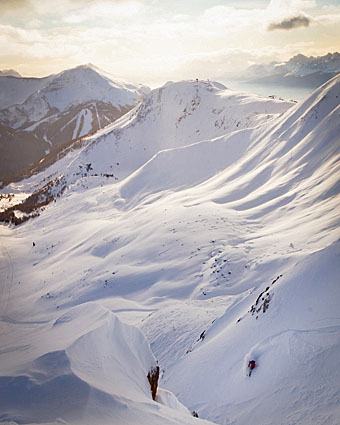
(foreground with Whitehorn 2 gullies in the background)
comes from a volunteer ski patrol poaching
the closed run while wearing his icononic
brown jacket and fanny pack.
Other names seem to have slipped by the “appropriate police.” As we glide down the flats of 133-Boomerang, we were passed by a group of young freeskiers who had ripped down from the long, steep funnel called 139-Brown Shirt Main. None seemed worried that a “brown shirt” was a member of the German Sturmtruppen and budding member of the Nazi Party. It’s undoubtedly a name that wouldn’t clear the marketing department now.
Isles assured me there are no fascist undertones, though. “It was named after a lone patroller skied it when it was closed one day.” While pro-patrollers were in red, readers may recall the colour of jackets on volunteer ski patrollers in those days were brown.
A NEW TRAIL MAP
So how will Lake Louise face the challenge of naming West Bowl’s many lines? Will resort brass court attention with exciting new names? On our day, we skied 108-Jackpot, for example (but we skipped 93-Powder Pockets, assuming it couldn’t live up to its promise).
The naming process starts with ski patrol and old-time staff coming up with a list of known names. All are brought to the table and whittled down. Marketing applies the sniff test and takes it to ownership for the final say.
Wherever they come from, there are three types of good run names and only three. The most obvious, but effective, is to name a run after the terrain itself: 92-The Heart or 115-Split Rock. The second way is the trickiest: humour. 29-Wrong Turn could be funny. Calling steep, expert cliffs 114-Kiddies’ Corner may be humorous (in a skiers’ humour kinda way) as well, mainly because there isn’t an easy way down or out once a skier ends up there.
The third way to name a run is to pick an appropriate theme and roll with it. A royal theme could work for West Bowl. Across the valley Mt. Victoria looms large, and below the monarch is Lake Louise itself, named after Victoria’s fourth daughter, Princess Louise. And with 31 runs at the resort already named after wildlife, surely there can’t be many animals left.
HUMBLE NAMES
Once I was done playing tour guide, I raced to my favourite line at Louise, 140-UNC (pronounced un-ck even though it’s short for Upper North Cornice). There’s a skate, a traverse and a hike to get to it. It’s a hidden line in some ways, like how its name is hidden behind an acronym. Uninspired? You bet. It’s directly above North Cornice. But some find that boring names keep the masses away. Next door is 141-Boundary Bowl, which lures skiers with images of being out there on the limits.
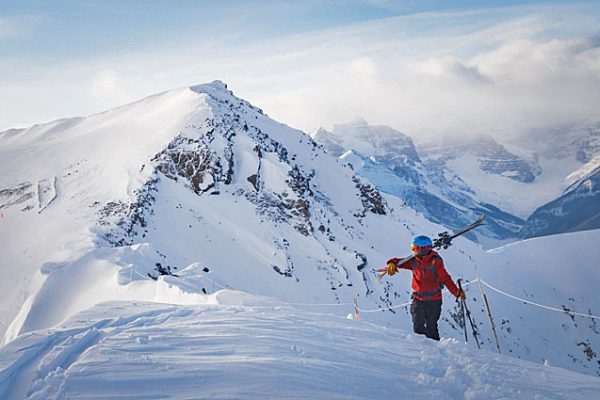
140-UNC starts with a tight turn around rock that reveals the chute below. It’s steep, and you gain speed as it widens. A ridge on your left forms a bank that bounces you back down the fall line. With rocks below, the turns matter. But I get in the groove on this run almost every time. By the middle, I’m in the flow and imagining someone out there watching. If I’m skiing half as good as it feels like, maybe they’ll rename the line after me someday.
DECISIONS
Months after our day studying existing run names and hypothesizing about what they would do with West Bowl, it seems we have our answer. And it’s better than we would have expected. In honour of the vast terrain and its wild nature, Lake Louise has decided to take a minimal approach to names. Instead of titling every little line so the marketing department can claim more new runs, it’s decided to title general zones and keep existing names where possible. The main bowl will still be called West Bowl. The next bowl out keeps the cautionary name Instructors, and the closer line will remain Maintenance (named long ago because the old lift maintenance department enjoyed this secret stash). Few other names will be declared.
Deep Throat and Cheap Throat, for now, will simply not be labelled on the map. Those aren’t the only problems sidestepped by this broad naming strategy. The long, fast traverse through lodgepole pine that brought skiers back to the base from the entire area was always called Star Wars. It was a legendary series of monkey trails that diverged and braided, sending skiers down parallel paths. The blur of colour as partners flew past trees and behind bushes was reminiscent of the speeders’ battle in Return of the Jedi. Copyrights meant the name would change. It turns out the entire run would change, too.
With more traffic heading to West Bowl and staff needing a way to respond to accidents safely, a road was cut that easily catches skiers and gently guides them back to the base area. It’s the most significant physical change. For now, even this road will be nameless. The rest of the 200-hectare expansion will remain mostly wild. Skiers will be able to explore this terrain, find their favourite stashes, and even give them their own names when they recount the stories later at the bar.
